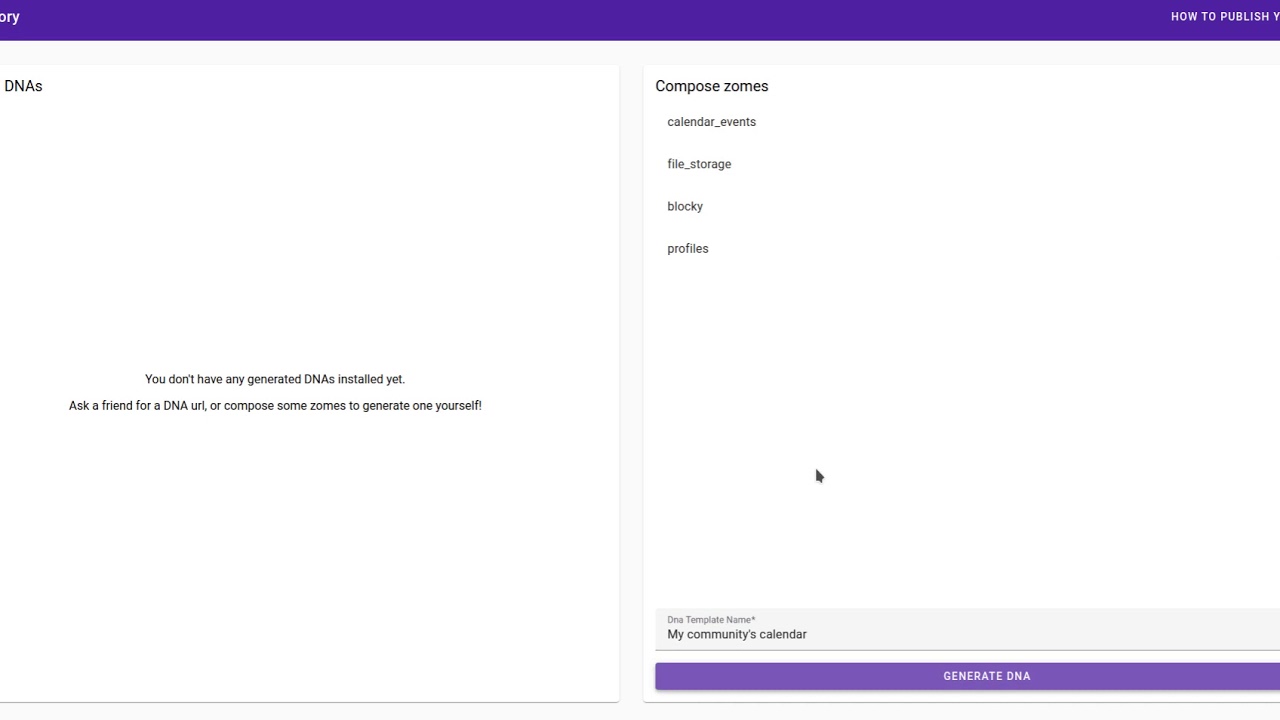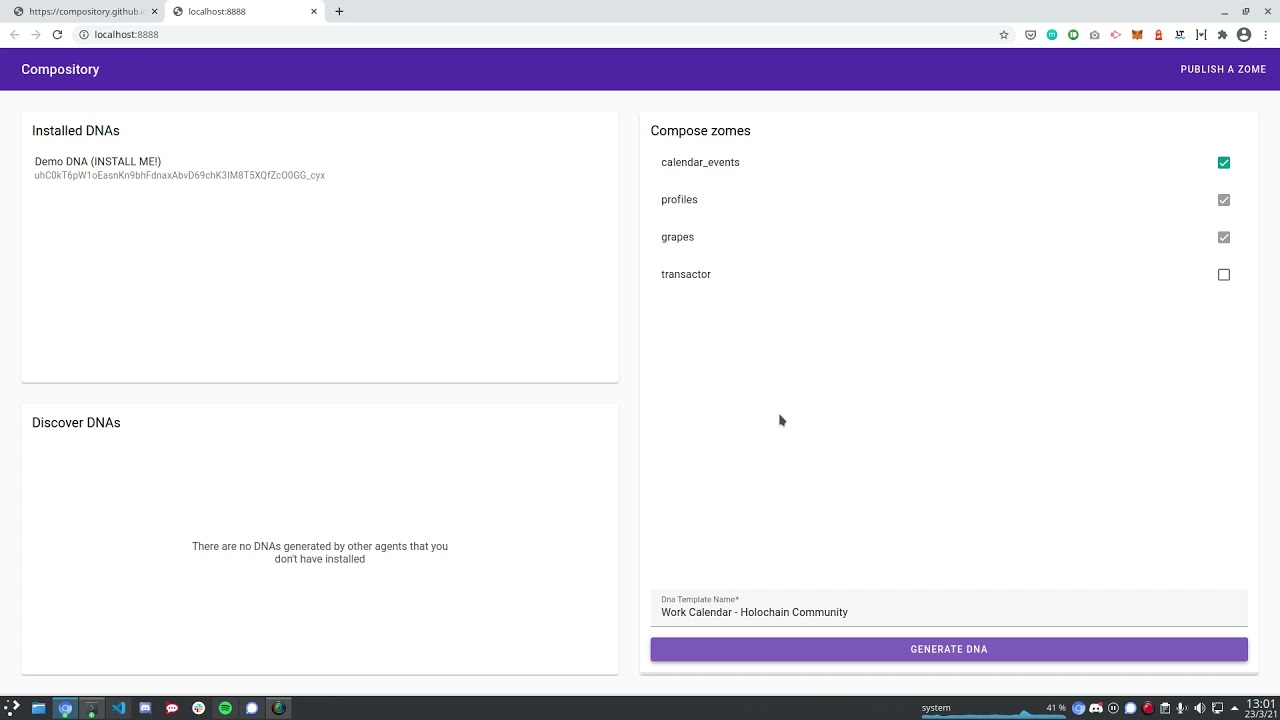Actually you don’t need to have holochain setup, just docker installed. Everything runs inside the docker container so you don’t even need rust or anything like that 
Also, just added non-terminal options for Windows and MacOs, let me know if anything doesn’t work or could be better explained.
Cool looks good bro. Will check out… 
Thank you this is a great concept!
and I confirm it all works out of the box here on arch linux.
sorry if this seems stupid, but I’m just not sure what I’m meant to do with the app itself once it loads. Say, I want to create a DNA from the available zomes - I can give it a new template name and choose ‘generate DNA’ in the app but then nothing seems to happen. What is the next step?
In console I can see ERROR about ("invalid wire: Failure(Failure { reason: \"Dropped message to kitsune-proxy:
and a similar gossip_loop warning, but they might be red herrings.
Thank you.
Hi @robot5x, thanks for trying this 
So this is an issue that other people have experimented as well, I’m trying to investigate it. It seems that sometimes holochain cannot find the files for the zomes, but it’s a hit and miss. Can you try two or three times more to see if it works?
FYI, I’ve been seeing issues of the type Entry not found, which we are investigating with the core devs.
Meanwhile, I’ve had to set my holoport to reboot every 3 minutes, which fixes the problem. So, if you’re trying this, give it some time after booting up the docker image and then retry 
thanks @guillemcordoba yes I think I needed to be patient it is all good now. I can generate a DNA and edit/save layout etc. Very nice! 
this will be very powerful.
Do you see the Compository growing into something like Notion.so? I started using Notion yesterday and it blew my mind, and I feel that Holochain is the perfect backbone to build an open operative system with that type of interface.
Well in some ways yes, in some ways no. The future of the compository is very much in the air, I don’t have fixed plans for it other than continuing the conversations around it to explore the possibilities to best fit the different functions it can perform.
One thing that is possible with this infrastructure is the cross-dht dynamic reading of data, which is quite exciting for me. I guess this would be the “notion like” feature that you are thinking about, but in a much less controlled environment in which every app can render whatever components it wants to render the data.
So with the current tools is not practical to create a happ from combining multiple zomes and DNAs? And the purpose of compository is to make this simple on both the Holochain level and the UI level? Did I understand correctly?
I’m see the compository as a piece of the puzzle, like, I imagine it as a part of the interface to create custom holo-widgets that you can easily share with friends by sharing a page like in Notion (or Anytype, which is a decentralized alternative that’s being built for IPFS)
Well, it is practical and easy to do as a developer, not as a non-technical person. The idea is to allow people to bootstrap their own games with their own rules (in holochain language, dnas), without requiring development skills or huge amounts of time.
I also see the compository as one piece, that we could plug other processes into. The idea is not at all for itself to become an ecosystem like Anytype or Notion, much more to be some kind of low-code bootstrapping / app generation tool.
I love the perspective of Holochain apps as games; it’s so much easier to communicate and grasp. It also opens a new way to think about and design apps; imagining you are playing a tabletop game with other people!
@guillemcordoba if and when you are ready, have time and interest, etc, a demo showing how you want to use this would be lovely.
Even better if recorded…
Or if you have already done something like that and I missed it, and I can find it, I’ll watch it now.
Thanks.
Hey! So I have really short 3 mins demo videos, but this is still very early, and it may be difficult to show the larger vision with them. What would you want the demo for exactly? If I for example create some DNA for a community with mutual-credit blocks, add some context, and show two agents exchanging, would that be enough?
Otherwise happy to jump on a call also 
That’s ok. Pls send links? I’ll watch them.
I have been thinking about how communities can assemble hApps from various components, and it seems like you are trying to do it, so I am interested and want to learn more.
Sure!
Maybe after I watch the 3 mins videos you already got? Then I might have better questions.
Brilliant! Thanks for creating and embedding here. I may have many questions. But first, I need to look at those modules…might answer some of them.
First questions:
- Where does the Compository UI get the building blocks that can be selected for composition?
1.1. Does it list all available Building Blocks? If so, are they cataloged or registered somewhere? - Does a module need to follow some standards to be a Building Block?
2.1. Is that was the Grapes are about?
[edited] - @guillemcordoba have you tried, and do you have examples of, using blocks together where data flows from one block to another?
This is amazing!
- There is a big open compository DNA, in which at the moment anyone can publish zomes. There is a button for that in the UI itself if you wanted to try it out. When publishing zomes, you need to provide the .wasm file and a separate .js file. These files are uploaded to a complementary file-storage-provider DHT and available to download, and the zome definition is available to everyone in the compository DHT.
Then, when someone enters the compository UI, they list all the available zomes that exist in the network. They select the zomes that they want for their DNA, and generate and install the DNA from those. That new instance of the DNA is also published to the compository DHT for everyone to discover in the “Discover DNAs” section.
Once they enter in the DNA, we know all the zomes that that DNA supports, and we can go fetch the UI files for those zomes. Once we get each of the files, we import their contents and we get all the blocks available for this zome (as per the interface defined below). We aggregate those and now we have the list of available blocks that can be added for this DNA. Now it’s just a matter of configuring Grapes to have those blocks available, and the blocks are autonomous in fetching the data and interacting with the conductor, so we just have to instantiate them passing the conductor-api handle and the CellId that the zome lives in.
In the future I would like for the zome to import and contain that .js file in itself and expose aui_modulefunction or similar, to avoid depending on an external compository DNA. That will speed up the loading of the UI by a lot also, and will decouple the DNAs so that the agents participating in the generated DNAs don’t need to also have the compository installed. - Yes, the .js file needs to export exactly this format. This is not incomplete by any means and can change, but the idea is that with a render function you can do pretty much whatever you want to render your elements (even something like Vue or React). I also could do the transition from the previous block-board element to grapes without changing that interface, which gives me confidence in it at least for now.
- I haven’t tried but I’m really tempted by something like Rete. Problems arise in versioning, schema changes, compatibility between modules… It’s not an easy problem to solve, I have some ideas but it’s very early for that still. Do you know any approaches that would fit here that I may not be aware of?


